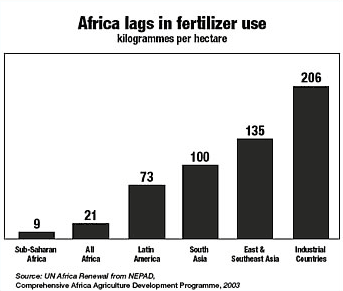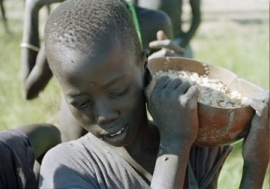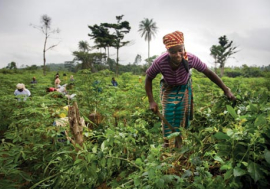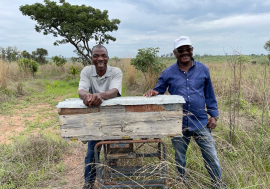Boosting African farm yields
Boosting African farm yields
Emily Miyanda is luckier than most farmers in hunger-plagued Zambia. With 6 hectares of irrigated land only a dozen kilometres from the capital, Ms. Miyanda produces maize and vegetables for the big Lusaka market. She hires her neighbours to help with planting and harvesting. But even with those advantages, she is squeezed between the high costs of what she needs to buy and the low prices her produce fetches at market. “We’d like some government support in buying seeds and fertilizer,” Ms. Miyanda told the BBC earlier this year. “That would make life easier.”
For tens of millions of people in rural Africa, life is getting harder. Reliant on erratic rains, working exhausted soil and hobbled by decades of underinvestment and neglect by national governments and international donors, many have sunk deeper into poverty as African agriculture — the mainstay of the region’s economy — continues to face neglect. A growing number of African governments and UN and non-governmental agencies argue that unless urgent efforts are made to raise crop yields, build transportation and marketing systems and adopt modern, sustainable farming methods, the continent will fail to reach its development goals and the rural majority will reap only meagre harvests.
 Cotton farmer in Burkina Faso with NPK fertilizer: Africa's nutrient-depleted soils need replenishment.
Cotton farmer in Burkina Faso with NPK fertilizer: Africa's nutrient-depleted soils need replenishment.Development blueprint
It is difficult to overestimate the importance of agriculture to Africa’s economic prospects. More than 65 per cent of sub-Saharan Africa’s estimated 750 million people are engaged in agriculture, and the sector generates more than a quarter of gross domestic product in most countries. Farm produce accounts for about 20 per cent of Africa’s international trade and is a major source of raw materials for industry.
In recognition of its importance, proponents of the continental development plan, the New Partnership for Africa’s Development, released NEPAD’s Comprehensive Africa Agriculture Development Programme (CAADP) in 2003 (see Africa Recovery, January 2004). Its goals are ambitious — to reach rural growth rates of 6 per cent annually by 2015, integrate and invigorate regional and national agricultural markets, significantly increase agricultural exports, transform Africa into a “strategic player” in global agricultural science and technology, practice sound environmental and land management techniques, and reduce rural poverty. The plan identifies four key areas, or pillars, of an investment plan for revitalizing the rural economy, including:
- expanding the acreage of irrigated African farmland and improving land management and farming techniques to preserve and improve soil quality
- investing in rural infrastructure, including roads and railways, storage and processing facilities, markets, communications systems and reliable supply networks for farmers
- making food production a high priority, both to combat hunger and for export, and improving emergency responses to natural disasters and conflicts
- strengthening African agricultural research and development, including in advanced technologies and farming methods, and disseminating advances quickly and efficiently to farmers, suppliers and buyers.
The CAADP plan emphasizes coordinated regional action in each of the continent’s diverse climate zones and relies on existing regional economic organizations and national governments for implementation. The total cost of the programme from 2002 through 2015 is estimated at $251 bn — about $18 bn a year. Although the blueprint envisages donor financing for a portion of the total, analysts note that Africa’s agricultural imports currently average about $19 bn annually — suggesting that a significant portion of the costs can eventually be covered by African countries as they cut their spending on imports.
‘Mined of life’
However, the challenges to success are as large as the potential consequences of failure. The UN’s World Food Programme estimates that more than 30 million Africans are currently in need of international food aid. Researchers for the African Union reported in January that annual population growth has outstripped food production on the continent since 1993, resulting in a 20 per cent rise in the number of hungry people — from 176 million to 210 million. Commercial exports have fared no better, with Africa’s share of world trade declining for nine of its 10 largest export crops.
One important obstacle to increased productivity has been the steady deterioration of Africa’s soils, noted Mr. Amit Roy, the head of the International Fertilizer Development Centre (IFDC), a US-based institute that promotes agricultural advancement in developing countries. “Today three-quarters of Africa’s farmlands — some 170 mn hectares [420 mn acres] is degraded,” he told reporters in New York in late March. “As a result, grain yield has stagnated at 1 tonne per hectare, compared to the world average of about 3 tonnes.” Crops consume upwards of 45 kilogrammes of nutrients and minerals from each hectare of land every season, he noted, a process known as nutrient mining. “When farmers plant the same fields season after season and cannot afford to replace the soil nutrients taken up by their crops, the soil is literally mined of life.”
“Africa needs to do a better job in applying science and technology to agricultural problems, and getting those advances to the farmer more quickly.”
— Amit Roy, International Fertilizer Development Centre
An estimated 8 mn tonnes of nutrients are depleted annually. Replenishing the nitrogen, potassium, phosphorus and other minerals absorbed by plants is therefore vital to keep crop yields from declining. Part of the answer lies in better farming methods, including expanding the range of crops grown, improving soil conservation practices and utilizing improved seeds and technology. But the key to launching a “revolution” in African agriculture, Mr. Roy told Africa Renewal, is much greater use of fertilizer.
In Asia and Latin America, farmers have dramatically improved harvests by improving the productivity of existing land, whereas in Africa, farmers have sought greater output by cultivating more land. “Traditionally, African farmers use the slash-and-burn method,” he said. “They burn off a section of land and farm it for a season or two, then clear another plot and leave the old field fallow.” But population increases and growing land shortages have forced farmers to cultivate the same fields repeatedly, stripping the land of nutrients and resulting in smaller harvests and less income. Such pressures have also led farmers to clear land poorly suited for cultivation, which contributes to soil erosion and yields only marginal increases in harvests.
An estimated 50,000 hectares of Africa’s forests and 60,000 hectares of savannah are lost to such methods annually — resulting in severe environmental degradation and contributing to a 20-year decline in agricultural production per capita.
According to the CAADP, African farmers currently use far less fertilizer than their counterparts in other regions of the world (see graph). “A strong relationship exists between the level of fertilizer use and cereal yield,” notes the programme.

In a study prepared for the 9-13 June Africa Fertilizer Summit, called by the African Union to focus attention on the African soils crisis, IFDC researchers Julio Henao and Carlos Baanante noted that fertilizer use in Africa is less than a tenth the world average of 100 kilogrammes. Nearly two-thirds of Africa’s fertilizer is consumed in just five countries, Ethiopia, Kenya, South Africa, Zimbabwe and Nigeria, primarily in the commercial and export sectors. “Negligible fertilizer use by smallholder farmers,” they asserted, “is a major factor in the region’s declining farm yield per person, which has exacerbated hunger and undernutrition.”
High costs, short supply
Heavy reliance on imported fertilizers, combined with high transportation costs and the absence of suppliers in the countryside, has meant that African farmers pay between two and six times the average world price for fertilizer — when they can find it at all. The IFDC study estimated that it costs more to move a kilogramme of fertilizer from an African port to a farm 100 kilometres inland than it costs to move it from a factory in the US to the port. With millions of African family farmers surviving on less than a dollar a day, imported fertilizer is simply unaffordable.
Yet evidence suggests that even modest increases in the use of fertilizer — whether nitrogen, phosphorous or potassium — can have dramatic results. In Ethiopia, one study found that just one bottle cap’s worth of chemical fertilizer on each plant increased millet yields exponentially. The technique, known as “micro-dosing,” is regarded as particularly appropriate for Africa’s small-scale farmers, because it reduces costs and avoids damage to fragile soils from excessive chemical use.
Citing the potential environmental risks to African soils and water sources from too much chemical fertilizer being applied to farms — as sometimes happened during Asia’s “green revolution” — proponents of sustainable agriculture in Africa argue that farmers should use more animal manure, compost and other organic fertilizers. If farmers better integrate stock-raising with crop cultivation, cattle and other livestock could provide them with not only more manure but also with animal traction for ploughing fields and hauling crops after they are harvested.
While organic fertilizers are important, agrees Mr. Roy, he points to a serious limitation. “The quality of animal manure is dependent on the quality of the food the animals are fed.” With much soil severely depleted, he says, “the fodder contains little of the nutrients needed by crops.” Organic fertilizers alone “are simply not the answer to the crisis of Africa’s soil fertility. We need to increase the use of both organic and chemical fertilizers.”
The CAADP makes the same point. Under the new, integrated approach to African agriculture advocated by NEPAD, “mineral fertilizers and organic matter are treated as complements rather than substitutes.”
One way to make chemical fertilizers more available and affordable is to increase local production. This can reduce costs, ease the pressure on foreign currency reserves and shorten the supply chain to farmers. Although Africa consumes only about 1 per cent of global fertilizer production and currently produces even less, prospects for the commercial manufacture of fertilizers are good. Nitrogen is among the most common elements on earth, but converting it into use for plants is energy-intensive. West Africa’s vast and largely untapped natural gas resources, notes Mr. Roy, therefore make the region ideally suited for the manufacture of nitrogen fertilizer. Africa also has ample deposits of phosphorus and already exports the mineral to Chinese and Indian farmers. If these minerals can be utilized in local production, Africa would need to import only potassium fertilizer.
But investment in fertilizer production will only come in response to increased demand from farmers, Mr. Roy asserts. Persuading Africa’s family farmers that purchasing fertilizer is worth the money and effort will require significant improvements in rural transport networks and infrastructure, an expanded network of rural farm suppliers and markets, and greater financial returns, including protection from price fluctuations and subsidized Northern competitors.
Fertilizer no ‘silver bullet’
“Fertilizer is not a silver bullet for Africa’s agricultural problems,” Mr. Roy admits. “The fertilizer doesn’t help if it arrives too late, or the crops aren’t watered or you can’t sell the harvest. Farmers know this. That is why CAADP is so important. It addresses the needs of farmers comprehensively.”
In the face of erratic and unreliable rainfall in large swaths of East and Southern Africa, expanding the acreage of irrigated land is also urgent. In February, UN Food and Agriculture Organization Director-General Jacques Diouf told African agriculture ministers gathered in Bamako that just 4 per cent of sub-Saharan Africa’s arable land is irrigated, compared with 38 per cent in Asia. Although much of Africa has abundant water supplies, he noted, “the region uses less than 3 per cent of its water resources, the lowest percentage of the developing world.” NEPAD researchers have estimated the initial investment of irrigating 20 mn more hectares of African farmland at $37 bn, with an additional $31 bn in operating costs through 2015.
In the absence of such resources, some innovative local initiatives show promise. In Dowa, Malawi, Glyvyns Chinkhuntha has built a gravity-powered irrigation system for his 20-hectare farm using only hoes and shovels. Drawing on water from a nearby river, he has created a system of irrigation canals only as wide as a hoe blade. By blocking or unblocking individual channels with dirt, he is able to direct water where it is needed. This proves, Mr. Chinkhuntha told the US newspaper the Christian Science Monitor, that homegrown solutions to Africa’s agricultural problems do exist. “Africa would have plenty to eat,” he said, if farmers could gain more education and training. “All the knowledge and information is tucked up in offices,” he lamented, instead of at work in the fields.
Rebuilding rural supply networks and marketing systems so farmers have the means and incentives to produce more is another major challenge. Government-run agriculture marketing boards used to perform some of these functions, providing stable prices, credit extension services, improved seeds and technology to local farmers. But as South African researchers Raj Patel and Alexa Delwiche have noted, most boards were liquidated in the 1980s and 1990s as a result of privatization policies promoted by the International Monetary Fund and World Bank. “Now, in addition to enduring direct exposure to international market fluctuations, farmers are often unsure when private buyers will appear, and are thus forced to sell cheap to the first trader,” they wrote in a 2002 study for the US non-governmental organization Food First. The difficulties of transportation and shipping also mean that outlying areas often are not covered by private buyers, a problem faced by suppliers of fertilizers, seeds and other farm inputs as well.
Mr. Roy says that expanding private sector involvement in rural marketing and supply activities is a long-term solution. But he acknowledges that high poverty rates in the countryside and the need for “public goods” like roads and markets give African governments a key role in creating incentives for private investment.
In 1998, a pilot programme launched by the government and donor agencies in Malawi distributed small “starter packs” of fertilizer and improved seeds to virtually every rural household. Although the project was successful, its high cost and lack of sustainability limited its adoption on a larger scale. In Kenya, Mr. Roy says, the government chose to enable the private sector through greater investment in infrastructure, while other governments have used a combination of subsidies and private sector incentives to try to meet farmers’ needs.
Finally, Mr. Roy observes, “Africa needs to do a better job in applying science and technology to agricultural problems, and getting those advances to the farmer more quickly.” Here too there are encouraging signs. In 1997, scientists at the West Africa Rice Development Association developed hardy new varieties that combine the best of African and Asian types to sharply improve yields (see Africa Renewal, January 2004). NEPAD and the Nigerian-based International Institute for Tropical Agriculture are working to promote and improve another West and Central African staple, cassava, through the pan-African cassava initiative (see Cassava).
Expanded and more effective extension services can also bring big dividends by improving land- and water-management techniques, introducing new techniques (such as rotating crops and mixing different crops on the same farm) and bringing scientific expertise and new technologies to farmers quickly.
“The African farmer is primarily a woman farmer,” Mr. Roy concludes. “And she is a good farmer who can feed her family and her continent if she is given the tools and the opportunities to do so.”















